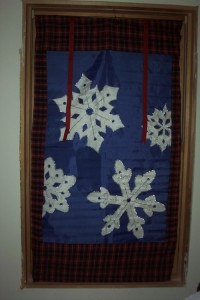It never fails — no matter how early or late it happens, that first moment when I see that flash of blue…hear that soft, watery warble and finally register that there are a dozen or more Bluebirds in my front yard, for a split second, I can barely breathe.
Journal Entry – February 1st ’08
The Bluebirds are here! This is the earliest they’ve ever arrived and the ground is frozen! I need to get a rush order placed with Grubco and run to Petsmart for a couple of little cartons of mealworms to tide us over!
Last month, I wrote about “new traditions,” and although I still think of “deep winter” in terms of things I grew up with many miles north of here, there is no denying that here in the Mid-Atlantic, the arrival of the first flock of hearty little balls of winged blue fluff has become part of February into March that is a testament to the natural knowing of animals. Whether they read signs that point to winter ending soon can only be conjecture; but it’s been proven that Eastern Bluebirds do know, from one season to the next, where they can expect to find safe nesting places and where there is likely to be food. In the seven years I’ve owned this land, the collection of nest boxes has burgeoned from one to six, and in the months when they arrive while the ground is either frozen or covered with snow, there are emergency provisions offered up in ceramic plant saucers that are always emptied by day’s end.
There are probably dozens of websites and print articles on how to build all manner of Bluebird houses, so I won’t belabor those or try to convince anyone that one style is better than the rest; but anyone who’s new to hosting Bluebirds could easily be overwhelmed by all the “must do’s” and endless rules about what should and should not be done. I have found that a few simple things have ensured return visits and multiple families of Blues nesting here, and producing what appear to be lovely, healthy families – often, more than once in each season.
To begin, the notion of bird boxes being invaded and robbed by snakes, raccoons, opossums, etc was more than we wanted to chance, so all our boxes are mounted on smooth steel pipes with a threaded end up, on which is screwed a sturdy steel escutcheon which is then fastened with screws to the underside of each box. This makes taking the boxes down easy after the end of each season, and predators have never been able to climb the smooth pipes. We have noticed too that when we take the boxes down to empty them, there are often a few small, fuzzy black spiders in the corners of the boxes. I strongly suspect that they are the reason we’ve not been troubled by blowflies or other insects that might harm the birds, and we take care to relocate them safely, treating them like the beneficial collaborators that they are.
Now, I’ve seen websites that advocate using Sevin dust on the inside of bird boxes to kill off mites or other small invaders, but we tend to err on the side of caution where the use of any type of insecticide is concerned, and have developed a “soak & singe” method that leaves the boxes quite clean without any chemical residue. Simply put, each house, once emptied of old nest material and eight-legged bug patrol, is submerged in a standard five-gallon bucket full of water for about twenty to thirty minutes – basically just long enough for the wood to be saturated. There’s no need to put anything in the water unless you’re in an area that’s especially prone to insects and you don’t have the benefit of the little spiders, in which case you might want to add a cup of vinegar.
Next, the “singe” part: lay the bird box, open side up, on a fireproof surface. We have a gravel driveway that’s just the ticket and we make sure the dog and any curious cats are in the house for this step. Using a propane blowtorch, the entire inside of the box is gone over, producing a cleansing steam. When you’ve done this once or twice you’ll get a feel for how quickly you need to keep the torch moving to avoid producing scorch marks; but by and large, what you’re striving for is to completely dry out the inside of the box, killing off any potential hazards in the process. The box is then fastened back on top of its metal post and, when the birds arrive, a handful of excelsior or some other clean, dry bedding material is added to give them a head start. We have a large, open pasture where the birds can find grasses to nest with, but we also put out scraps of yarn, hair from the dog’s brush, dryer lint and anything else that can be pulled off a nail under the shelter of the covered doorway to the barn.
Along with providing good places for nesting, we’ve also taken to providing food. It’s been interesting to note that although the Blues will happily gobble a handful of mealworms when the ground is frozen, they don’t become lazy or dependent – the moment there’s a day above freezing and insects are hatching or worms are emerging from roadside culverts, the Bluebirds are hunting and finding their own food. That said, when we do feed them, what we offer are mealworms and bits of finely chopped fruit, occasionally mixed with crumbs soaked in oil.
If we lived in a harsher climate where the nesting period were shorter, I might roll the mealworms in a calcium supplement powder such as Osteoform, but that hasn’t been an issue here because of the abundance and variety of food sources for them. If you order from a mail-order supplier such as Grubco, the worms arrive in containers that can be kept in the refrigerator. They stay in a state of torpor until they’re taken out and allowed to get up to room temperature. A plant saucer with smooth, steep sides makes a good “serving dish” and a similar dish with fresh water is always welcome if there are no sources nearby.
Along with the Bluebirds, we’ve seen Tree Swallows using our houses (hence the growing number of boxes!) and find that they too are a delight to watch, hunting on the fly and swooping very near us. Shortly after them, the Goldfinches join the party. It’s always the Blues who arrive first though, staking out their favorite houses and settling in for the season. This year they arrived on the first day of February, a full three weeks earlier than in years past. I haven’t done any research on how or why a groundhog in Pennsylvania was chosen as the “prognosticator” of the arrival of Spring, but if I were a gambling woman, my money would be on the Bluebirds every time.
































